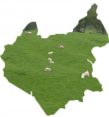Appleby Magna was partially in Derbyshire and partially in Leicestershire until 1897, when the county boundary was moved and the whole of the parish became part of Leicestershire. Although a small village, it had a large and wealthy endowed school, which would have attracted boarders from a wide area. Norton-juxta-Twycross is two miles south of Appleby Magna, and is a separate ancient parish, which contains the township of Bilstone.
Appleby Magna
No non-conformists were recorded in 1676.
Presbyterians
A Presbyterian meeting at Appleby Magna and Snarestone was recorded in 1705, attended by 70 hearers, of whom 14 qualified for the vote. Their leaders were John Harris, James Hancox and John Baddely. A previous leader, James Paul, had been removed.
There was a Presbyterian meeting house in Appleby Magna in 1706, and six Presbyterians in the village. In 1709 there were five Presbyterian families, and there was a meeting every Sunday. In 1712 there were 16 Presbyterians meeting ‘every Sunday or oftener’ in the village, including eight from Appleby Magna. Their teacher was Edward Boutcher.
Quaker
One resident in 1706 and 1709 was said to be a Quaker.
General Baptists
The General Baptist chapel was built in 1820, and 60 people were said to meet for worship there in 1829. In 1851 it was said to have 80 sittings, together with room for a further 20 people to stand. There was only one service on Sunday 30 March that year, in the evening, and 80 worshippers attended. There was no Sunday school. It may have been extended, as a directory of 1908 records the chapel as having 200 sittings, while later directories put the number of sittings back at 100.
Particular Baptists
This chapel, known as Hope Chapel, is said to have been provided by George (or William) Hear in 1825, and endowed with 1.5 acres of land. There were relatively few Particular Baptist congregations in north-west Leicestershire (although there was a small meeting in Norton-juxta-Twycross and may have been congregations in south-east Derbyshire), and this may account for the 150 people said to worship there in 1829. That said, this figures is probably an exaggeration, as in 1851 the chapel was said to have seating for just 22 worshippers, and on Sunday 30 March 1851, 18 attended the morning service, while 40 people crowded into the building that evening. There was no Sunday school. By 1863, five cottages had been built on the land held in trust for the chapel, which generated an annual income of £20, presumably to pay a stipend for the minister. The chapel closed in 1974, and is now a house.
Wesleyan Methodists
This chapel was built in 1840, with 60 free and 8 other sittings. There was a single service on Sunday 30 March 1851, in the evening, with 52 worshippers present.
Norton juxta Twycross
Particular Baptists
Twenty Particular Baptists were said to assemble for worship in this parish in 1829, although no other records of this congregation have yet been found. They appear to have met within Norton itself, as there is a separate entry in the return for Bilstone, where no nonconformist meetings are noted.
Primitive Methodists
This chapel appears to have been short-lived. It is noted in a directory of 1881, and on the 1883 OS map, but was no longer there in 1903.
Bilstone
No nonconformist congregations have been identified as meeting in the township of Bilstone.
Return to Protestant Nonconformity: A-Z
Sources
- A. Whiteman, The Compton Census of 1676: A Critical Edition (London, 1986)
- John Evans’ List of Dissenting Congregations (Dr Williams’s Library MS 34.4
- J. Broad (ed.), Bishop Wake’s summary of visitation returns from the diocese of Lincoln, 1706-1715. Part 2, Outside Lincolnshire (Oxford, 2012)
- Leicestershire trade directories
- 1829 Meeting House return
- 1851 ecclesiastical census
- RCHM, Nonconformist Chapels and Meeting-houses in Central England (London, 1986).
